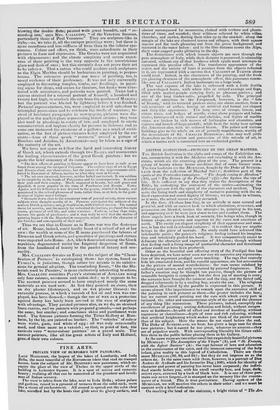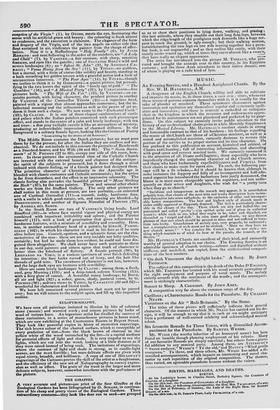BP.ITISII INSTITUTION — PICTURES HY THE GREAT MASTERS. THE British Institution is
the alpha and omega of the Exhibition sea- son, commencing it with the Moderns and concluding it with the An- cients, which are the crowning glory of the year. The present is a galaxy of beauty whose lustre outshines that of some former ones. The two loadstars are the Muatt.Los, bought by the Duke of SUTHER• LA ND from the collection of Marshal SOULT ; doubtless part of the spoils of the Peninsular campaigns. " The Angels coining to Abraham" (10), and " The Return of the Prodigal" (2.2)—the figures the size of life. It is sufficient to say that they realize the descriptions of the Bible, by embodying the sentiment of the stories—animating the different persons with the spirit of the characters and incident. They unite the living truth and simplicity of narrative-painting with the re- fined expression and moral dignity of history; we are made to witness, as it were, the actual scenes as they occurred.
In the first, Abraham kne:ling, in an attitude at once natural and graceful, and with an earnest look in which admiration, reverence, and persuasion are blended, invites the strangers in, pointing to his tent, and appearing as if he were just about to rise and conduct them. The three angels have a frank look of serenity, like beings who, though in human snape, are passive and superior to the cares and emotions of earth. The rustic yet elegant simplicity of their appearance and man.. ner, is but the veil to celestial radiance : it is evident they are angelic beings in the guise of mortals. No study could have achieved this indefinable point ; the painter's religious feeling imbued his imagina- tion and intuitively guided his hand. It was comparatively easier to delineate the character arid expression of Abraham ; though without that feeling such a living image of patriarchal character and devotional ardour could not have been produced.
Often as the beautiful and affecting story of the Prodigal Son has been depicted, we have never seen nor can we conceive any represents. tion of the repentant prodigal more touching. The rags that scarcely hide his emaciated form, and his squalid appearance, are but accessories to the picture of mental wretchedness : the man seems subdued by suffering and sorrow, and only sustained by paternal forgiveness. The father's emotion may be thought too passive, hough the picture of venerable benignity is complete : but the first joy of meeting is over the servants have brought the raiment and the ring, and the fatted calf, dragged reluctantly in by a smiling boy, awaits the axe. The religious sentiment illustrated by the parable is expressed in this picture. It seems almost like impertinence to remark upon the executive skill of the painting in such pictures as these--the greater includes the less but we cannot avoid pointing out the care with which every part is imitated, the sober and unostentatious style of the art, and the absence of any thing like mannerism. These pictures, indeed, exemplify the excellences of painting ; uniting definition and finish, without meagre- ness or hardness--breadth of effect and freedom of bundling, without vagueness or slovenliness—depth of tone and rich colouring, without that artificial heightening which makes you think of the painter more than of his subject. Here the means do not stand before the ends The Duke of Su ['BERLAND, we hear, has given a large sum for these two pictures; but it cannot be too great, whatever its amount—they are of pripeless worth. With corresponding liberality bis Grace exhi- bits them to the public before placing them in his Gallery. In the same room are two other small but exquisitely beautiful Octures by Muatuo: " The Assumption of the Virgin" (3), and "St. Francis, with the Infant Saviour" (4): the rapt fervour of love and adoration in the countenance of the saint, and the innocent caressing of the holy infant, give reality to this legend of Catholicism. There are three more MURILLOS (89, 93, and 94); but they do not impress us as the others do. In the same room with them, however, is a portrait of Don Andres de Andrade and his favourite Dog (109), which for identity of character and power of painting has never been surpassed; the indivi- dual stands before you, with his small swarthy face, mid large, dark, ardent eyes, crowned by a bush of black hair. It is one of those poiu traits one never forgets—it is stamped on the memory like the counte- nance of a friend. This is true portraiture. Having spoken of the Muatwas, we will mention the others in their order : and we must be content with a brief indication.
Oa reaching the head of the staircase, a bright vision of "The 48, symption of the Virgin" (1), by GUIDO, meets the eye, fascinating the sense with its artificial grace and beauty : the colouring is fresh almost to crudeness, and the execution is elaborate. The elegance of the form and drapery of the Virgin, and of the two angels on either side that float sustained in air, vindicates the painter from the charge of affec- tation. Near it is a Raffaelesque "Holy Family" (6), by JULIO ROMANO : and next following in the order of the numbers are "A Lady and Child" (7), by VANDYKE—a fair creature, with sharp, sensitive features, and eyes like the gazelle ; one of SAL VATOR ROSA'S wild and severe landscapes (8) ; an "Infant St. John" (9), by ANNIBALE RACCI ; " Venus RiAing .from the Sea" (II), by TITIAN—no goddess, but a mortal, with a form of statue-like solidity and beauty, standing in a bath wreathing her golden tresses with a graceful action and a look of unconscious innocence. " The Four Ayes" (14), by TITIAN—though we incline to think it is by GIORGIONE—a quaint picture, but personi- fying in the two lovers the spirit of the "lovely age of gold." " The Gamblers" (16), and "A Musical Party" (21), by CARAVAGGIO—fine pictures both. " The Wife of he Vos" (19), by VANDYKE—an ex- quisite portrait, with living character, the pendant picture to another by VANDYKE of the Counsellor Trieste (25)—a sagacious head, painted with a vigour that almost approaches coarseness; but the in. tellectual meaning and the refinement as well as the power of art re- deem it from such a charge. We now come to the "Enchanted Castle" (23), by CLAUDE. It is one of those elegant combinations of castle and palace which the Italian painters conceived with such picturesque effect, and stands in the centre of a calm and lovely landscape, with sea and trees : a dim gray twilight enveils it like an atmosphere of mystery, producing an indescribable impression of charmed stillness. In the foreground is a solitary female figure, looking like theGenius of Poetry
"Lone sitting by the shores of old Romance."
The Middle Room contains the Dutch pictures ; but we must pass them by for the present, for after the Italian they are soulless and me. chanical. We do not include in this censure the portraits of Rembrandt as a Standard-bearer, and his Wife (34 and 36). The " Seven Sacra- ments" of N. POUSSIN (27 to 33), occupy one side of this room, how- ever. In these pictures the ceremonial rites of the Catholic Church are invested with the external beauty and elegance of the antique: the spirit of the subjects is preserved, but it flows through a mind imbued with classic feeling, as if a Greek painter had designed them. The primitive character of Christianity in the Apostolic age is blended with classic costumes and Catholic ceremonials; but the union is far from discordant, and the effect is an impressive solemnity. The classic feeling also pervades the beautiful picture of "Moses Striking the Rock" (37), by the same painter. These and several other choice works are from the Stafford Gallery. The only other pictures we shall notice in this room at present, are two portraits,--an animated one of Cardinal Gozzadini (71)—a smooth, ruddy, handsome face, with a smile in which good.nature, wit, and cunning are blended—by DOMENICHINO; and another of Signora Niccolini of Florence (73), by ANDREA DEL SARTO. In the South Room are two of VANDYKE'S living heads. Lord Strafford (88)—in whose face mental vigour and physical energy are combined with impatient irritability and spleen ; and the Painter himself (117), with a look of penetration that gives refinement to handsome features, with a mixture of sensibility and sensuality. Here, too, is another extraordinary head of a painter' by himself, PARME- GIANO (102); in which his character is read in his face as if he were alive before you. Conceit, egotism, and a splenetic furor, are the cha- racteristics of the man : these are not very amiable nor lofty qualities, certainly; but had he made them less evident, he could not have dis- guised them altogether. We shall never have such portraits as these in our day, until painters and sitters agree that truth of character is better than the falsehood of flattery. A female portrait (98), by LEONARDO DA VINCI, is a curious specimen of over finish defeating its intention : the face looks carved out of ivory, and the hair like threads of gold wire. The sweetness of character is not lost, however, and the large dark eyes are lustrous with sensibility. Here are some lovely landscapes by CLAUDE: among them, a fresh, cool, gray Morning (119); and a deep-toned, solemn Evening (115), with a fiery glow of sunset. A beautiful sunny landscape, by BOTH, all air and light (92) ; a sober, green, shady, pastoral scene, by G. Pout:ism (96) ; and two views in Venice, by CANALETTI (80 and 82)— wonderful for elaboration and literal truth.
We have left unnoticed several pictures that must not be passed over; but we will return to the subject again, and fill up this imperfect outline.



























 Previous page
Previous page